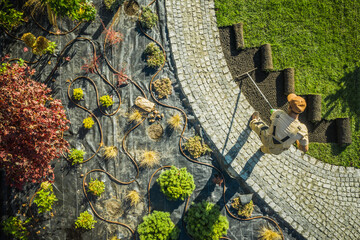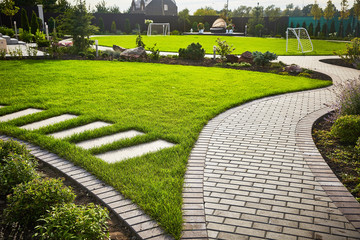A well-planned landscape increases the value of your property and adds a place to relax. It is also environmentally sustainable by utilizing resource-efficient plants and reducing water and fertilizer use.
Grass and plants are natural coolants, removing heat and saving on air conditioning costs. They produce life-giving oxygen, reduce carbon dioxide and dust, and capture toxins. Contact Palm Beach Landscaping for professional help.
A vibrant and diverse color scheme is a key element of landscape design. Flowers, shrubs, trees, and hardscape features like mulch, rock, and water features all add color to the garden. A professional landscaping company can use color to enhance the overall look of the garden and make it feel more inviting.
Color can also create contrast by pairing warm and cool colors together. Using a color wheel is a great way to determine the best color combinations in your landscape. For example, red tulips pair well with yellow dahlias and purple petunias. Or, brighter flowers like lilies and hydrangeas can balance out the more muted colors of tiger lily or black eyed susans.
Soft pinks, oranges, and yellows can give your landscape a more subtle pop of color. These colors are also balanced well by softer hues like grays and light blues.
Green is another essential color in landscape design. From the intense green of a holly or evergreen tree to the soft tints of mulch and gravel, it’s important that you choose the right shade for your landscape.
Offering seasonal color programs is a great way to attract customers and market your landscaping business. These programs can include planting flowering shrubs in spring and switching them out with plants that are more suitable for fall. Heroman says they tend to install spring plants around April and May and switch them out with fall plants in late October or early November. This gives their customers an opportunity to change up the look of their gardens seasonally and provides them with a unique feature that sets them apart from other properties in the neighborhood.
Form
Form refers to the overall shape of plants, trees, shrubs, and hardscape features. It can be used to create different types of effects in the landscape, such as formal, asymmetrical, or casual. Using the right combination of shapes and sizes can help a garden feel balanced, harmonious, and cohesive. Form is also a critical component of visual appeal. For example, the spiky form of a yucca plant contrasts nicely with the rounded shape of a boxwood hedge. The use of texture can add visual interest to the garden by creating a variety of sensations with the touch of the hand.
The function of a landscape includes its practical uses, such as recreational areas, water management, and navigation. It also considers environmental sustainability and maintenance requirements. For example, a garden can be designed to reduce water consumption through the use of drought-tolerant plants and permeable paving materials. A landscape can also be designed to enhance the visual impact of a building or home by matching its architectural style or creating a focal point.
A landscape design should strike a balance between function and aesthetics, with neither one overshadowing the other. For example, a reflective pool or artistic sculpture can have a spiritual value for some people but may not have any practical purpose in the garden.
To achieve a functional landscape, the designer should first conduct a site analysis to understand the property’s unique characteristics. This includes assessing the soil type, climate, existing vegetation, and drainage patterns. The results of this analysis will guide the design process and inform the selection of plants, placement of structures, and irrigation systems. In addition, the designer should provide visual focal points and include a range of seating options to suit a family’s needs.
Texture
The visual and tactile qualities of plant surfaces are the primary components of texture in a garden. The coarseness or fineness of leaves, the density and thickness of the foliage, and how it reacts to light are all considered in landscape design. Like color, it has a significant impact on the overall feel and personality of a garden or landscape.
Texture is often overlooked because it’s a very subtle attribute, but it’s important to incorporate into the landscape design. It’s best used in combination with other characteristics such as color and form. The combination of different textures creates depth and interest in a garden. It also adds movement and life to a garden. For example, the delicate, velvety leaves of lamb’s ear (Stachys byzantina) contrast with the sculptural branches of hollyhocks and the bold sword-shaped leaves of New Zealand flax (Phormium).
A trained landscape professional understands how to use varying textures to create the most appealing garden possible for their clients. It’s also important to consider how textures will change over time and how the weather will affect the plants. A well-designed garden is a living work of art that will evolve over time.
When considering the layout of a landscape, it is important to remember that there should be a smooth transition between different areas. For instance, a walkway should not abruptly end at the edge of a lawn or in the middle of a flower bed. Similarly, the different textures of plants should complement each other and blend together into a unified whole. This is especially important if you’re working with larger plants, such as trees and shrubs. For example, a mature birch or maple tree will have a coarser texture than a small ornamental pear or plum tree.
Rhythm
Like a beat is to music, rhythm creates a visual flow in landscape design. A rhythm can guide your eye from one element to the next, connect different areas, and evoke emotions and responses in the people who experience your landscape.
Rhythm can be created by using repetition of line, form, color or texture in a design. When used sparingly, this can be effective in establishing unity and movement within the landscape. However, too much repetition can lead to monotony and visual confusion. The key is to find a balance between variety and simplicity.
A stair-step transition from one element to the next can also be used to establish rhythm and harmony in a landscape. This can be done by varying the height of plants, creating curves and incline in a pathway, or stepping down the scale of materials from large to small (such as stones, plant heights, and textures). The resulting synchrony between these elements will help to guide the eye and provide a sense of balance.
The use of contrasting colors, shapes, sizes, textures and forms in a design can also add interest and visual tension. When used sparingly, this can highlight the importance of certain areas and bring attention to focal points in the landscape. When overused, this can detract from the overall impact and harmonize the composition as a whole.
As with balance, the key is to keep the number of elements used to a minimum. Overcomplicating a landscape can disrupt the visual balance, distract the eye, and reduce harmony. Simplicity can be achieved by limiting the number of different colors, textures, forms and construction materials used in a design and by adhering to a specific theme or style.
Unity
Unity is a design principle that refers to the overarching sense of integration and wholeness throughout your landscape. This can be achieved through a variety of methods, such as repetition and a sense of proportion and scale. It is important to balance unity with diversity, so that the landscape does not appear sterile or monotonous. One of the most important aspects of achieving this is color. It is important to use the right amount of color to add rhythm and accents, but not so much that it becomes distracting or unsightly. The correct color can also help to guide the eye, with bright colors advancing and receding, and neutral or natural colors providing depth and contrast.
The concept of interconnection is another important aspect of unity. This involves the physical linking of various features, such as paths, hardscape, or plant beds. This can be accomplished by using the same line, color, texture or form throughout the garden to create a sense of continuity and unity. For example, you could repeat the same type of edging around the entire garden or use the same color for the path and edge of the patio.
Another important aspect of this principle is proportion, which refers to the sizing relationship between different elements in the landscape. The ideal landscape should be proportional to the size of the house and surrounding area. Proportional landscapes look more elegant and are often a good choice for small spaces.
Finally, unity can be enhanced by using a theme to tie the landscape together. For example, you might choose to focus on a butterfly garden and incorporate flowers that butterflies love, such as liatris, phlox, and bee balm. You can also opt for more formal themes like a soothing Zen garden or a traditional English garden, with specific plants, trees, and accessories that work together to create the desired look.


